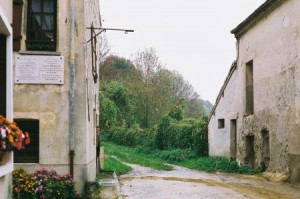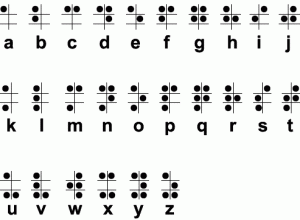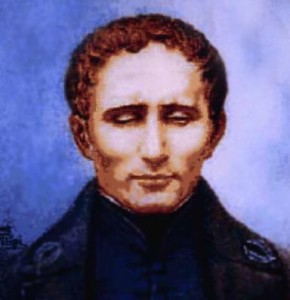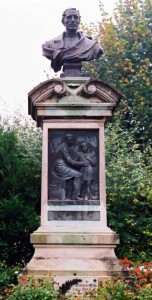The Early Years
Louis Braille was born on January 4, 1809, in , a small village 25 miles from Paris, France, to Monique and Simon-René Braille. His father was a successful businessman who owned farmland and a vineyard but was best known as a master craftsman of harnesses, saddles, and other leather goods.
Louis’ parents knew the importance of education and taught him to read and write by having him feel upholstery nails that had been hammered in the shape of letters and words into boards. The local priest, Abbé Palluy, also tutored Louis until he was 7 years old, when he was accepted in 1816 as a student at the local village school. Interestingly, he was enrolled with sighted children; apparently he was “mainstreamed” 200 years ago. By all accounts, Louis performed well in his studies.
A few years later, Abbé Palluy located a school in Paris that specialized in teaching blind students and believed that the 10-year-old Louis could profit by attending. In 1819, with the approval of his parents, Louis was enrolled in the Royal Institution for Blind Youth (after the French Revolution, the name was changed to the National Institute for the Young Blind).
At the time of Louis’ enrollment, the Institution (and school) consisted of a single building that was more than 200 years old and had been used as a prison during the French Revolution. It was filthy and had not been adapted for blind students. The meager meals provided were usually confined to porridge and slabs of doughy bread. The boy was also greatly disappointed to find that the Institution had very few books that were suitable for reading by blind students. These 14 books were “printed” using a system of embossing (raised lettering) that had been invented some years previously by the Institution’s founder, Valentin Haüy. Students read these books by using their fingers to trace the embossed letters and words while simultaneously sounding out each sentence word by cumbersome word.
During the next 5 years, Louis did well at school, excelling in academics and music. He was especially accomplished as a cellist, pianist, and organist.
In 1820, when Louis was just 12 years old, Alexander Francois-René Pignier, director of the Institution, invited Charles Barbier de la Serre to speak to its staff and students. An officer in the French Army, Barbier had invented a method whereby soldiers at the front could communicate with one another at night without resorting to speech or other utterances. His system, which he called “sonography,” involved punching 12 raised dots on cardboard in various positions to represent sounds in words. Barbier believed that this system could be a very useful way for people who were blind to learn to read and write. The Army soon lost interest in Barbier’s system, however, because soldiers found it too difficult to learn.
The Productive Years
Undeterred by the rejection of Barbier’s system, Louis believed that the general idea held promise for use with the blind. He set to work designing a simpler six-dot version in which combinations of dots and spaces representing graphemes (e.g., letters, numbers, punctuation marks) were depicted on a 2 x 3 grid. For 3 years, from 1822 to 1825, Braille perfected his six-dot embossed system. He was only 13 to 16 years old at the time.
In 1828, 19-year-old Louis was appointed an apprentice teacher at the Institution, where he taught both blind and sighted students. With a salary of 180 francs per year, his professional and adult life began. He was promoted to a full-time teaching position in 1833.
In 1829, Louis Braille published Method of Writing Words, Music and Plain Songs by Means of Dots for Use by the Blind and Arranged for Them (1829). Although in poor health, he published a second edition of this book in 1837 and Little Synopsis of Arithmetic for Beginners, his second book, in 1838. Both books were “printed” in braille, his six-dot system.
During the 1830s, Louis developed another system (called decapoint) that allowed people who were blind to communicate easily with sighted people. This system consisted of a set of 100 raised dots arranged on a 10 x 10 grid for writing letters of the Roman alphabet. Collaborating with Pierre-Francois-Victor Foucauld, another former Institution student, Louis created a precursor of the typewriter, a machine called a raphigraphe (needle writer) for mechanically writing decapoint. In 1843, the Society for Encouragement of National Industry awarded a platinum medal to Foucauld for the invention of the machine.
The Later Years
In 1840, a new director of the Institution, Pierre-Armand Dufau, was appointed. Dufau did not approve of either Haüy’s embossing method or Braille’s six-dot code. He even ordered the burning of 73 books that the Institution had produced using Haüy’s method. Dufau advocated for a new embossing system then used in the United States and Scotland; eventually this system was found to be less effective than Braille’s six-dot code. After 1845, Braille’s code became increasingly accepted, and in 1854 it was adopted as the authorized system in France for teaching literacy skills to people who were blind.
In 1835, when Louis was only 26, he had been diagnosed as having tuberculosis, a condition that he probably contracted some time previously. The effects of this illness required that he move to Coupvray in 1844 for three years of rest. He returned to the Institution in 1847, but his health continued to deteriorate. Louis Braille died on January 6, 1852, at 43 years of age. He was buried in Coupvray’s cemetery. In the years after his death, the extent of his contributions became increasingly evident and appreciated. In 1952, his body was reinterred in the Pantheon in Paris; his hands, however, remain in an urn in the village cemetery at Coupvray.
American Foundation of the Blind. (2009). Celebrating 200 years of braille. Retrieved from http://www.afb.org/LouisBrailleMuseum
Belusic, D. The life of Louis Braille. Retrieved from http://www.cfb.ca/newsite/Conventions/louisbraille-story.html
Herie, E. (2008, August). Six dots that changed the world: Remembrance of Louis Braille (1809-2009). Presentation at the Seventh World Blind Union General Assembly, Geneva, Switzerland. Retrieved from www.worldblindunion.org/en/documents/general-assembly/presentations/Louis-BrailleEulogy.doc+Six+Dots+That+Changed+the+
World&cd=1&hl=en&ct=clnk&gl=us
Kimbrough, P. (n.d.). How braille began. Retrieved from http://www.brailler.com/braillehx.htm
Liebs, A. (2008, Sept. 21). A biography of Louis Braille: His raised-dot language system brought literacy to the blind. Special Needs Education. Retrieved from http://blind-students.suite101.com/article.cfm/a_biography_of_louis_braille
Liebs, A. (2008, Sept. 21). A braille timeline: Braille struggled to become the primary language of the blind. Special Needs Education. Retrieved from http://blind-students.suite101.com/article.cfm/a_braille_timeline
Marsan, C., & Coudert, C. (2009, January). Braille 1809–2009: Writing with six dots and its future–A brief overview. Presentation at international conference at UNESCO headquarters, Paris, France. Retrieved from http://www.avh.asso.fr/rubriques/infos_braille/bicentenaire_louis_braille.php
Rathi, S. (2009). Louis Braille. Retrieved from http://www.eyeway.org/inspires/achievers/louis-braille/?searchterm=Louis%20Braille
Sydenham, S., & Thomas, R. (2009). Louis Braille [Online]. Retrieved from http://www.kidcyber.com.au/topics/Braille.htm?
Weiss, T. C. (2009). Louis Braille–Historical perspectives. Disabled World Disability and Health News. Retrieved from http://www.disabled-world.com/disability/types/vision/louis-braille.php
Image Credits:
Chudler, E.H. (2010). Braille Alpbabet Sheet. Neuroscience for Kids. Retrieved from http://faculty.washington.edu/chudler/gif/braille.gif
English-Online. (2008). Louis Braille. Braille – A Language for Blind People. Retrieved from http://www.english-online.at/society/braille/louis_braille.jpg
Louis Braille School. (2008). Stone House. Louis Braille’s Birthplace. Retrieved from http://louisbrailleschool.org/resources-image/stonehouse-2a.jpg
Louis Braille School. (2008). Braille Statue. Louis Braille Monument. Retrieved from http://louisbrailleschool.org/resources-image/brl-statue-r1.jpg
Please cite this information as follows: Hammill, D.D. (2010). Louis Braille (1809–1852). Hammill Institute Preservation Project. Retrieved from http://hammill-institute.org/hipp/?p=58




